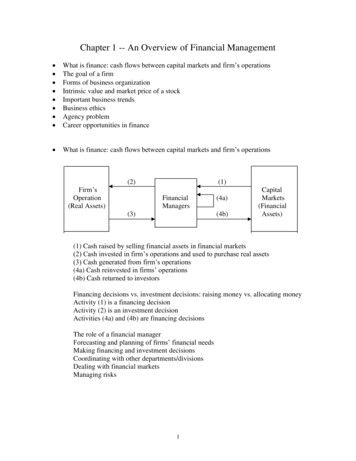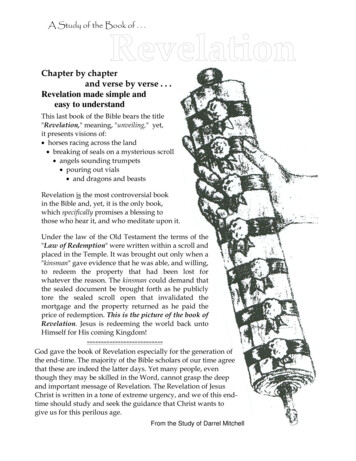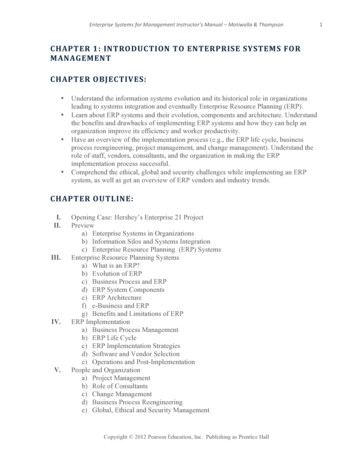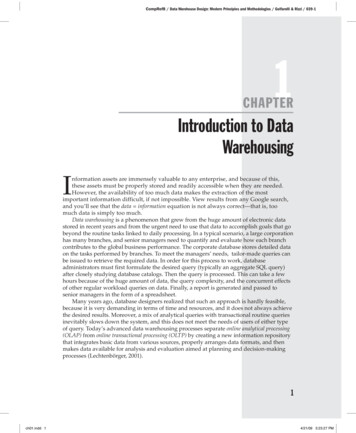
Transcription
Chapter 1 -- An Overview of Financial Management What is finance: cash flows between capital markets and firm’s operationsThe goal of a firmForms of business organizationIntrinsic value and market price of a stockImportant business trendsBusiness ethicsAgency problemCareer opportunities in finance What is finance: cash flows between capital markets and firm’s operations(2)Firm’sOperation(Real ts(FinancialAssets)(1) Cash raised by selling financial assets in financial markets(2) Cash invested in firm’s operations and used to purchase real assets(3) Cash generated from firm’s operations(4a) Cash reinvested in firms’ operations(4b) Cash returned to investorsFinancing decisions vs. investment decisions: raising money vs. allocating moneyActivity (1) is a financing decisionActivity (2) is an investment decisionActivities (4a) and (4b) are financing decisionsThe role of a financial managerForecasting and planning of firms’ financial needsMaking financing and investment decisionsCoordinating with other departments/divisionsDealing with financial marketsManaging risks1
Finance within an organization: importance of financeFinance includes three areas(1) Financial management: corporate finance, which deals with decisions relatedto how much and what types of assets a firm needs to acquire, how a firm shouldraise capital to purchase assets, and how a firm should do to maximize itsshareholders wealth - the focus of this class(2) Capital markets: study of financial markets and institutions, which deals withinterest rates, stocks, bonds, government securities, and other marketablesecurities. It also covers Federal Reserve System and its policies.(3) Investments: study of security analysis, portfolio theory, market analysis, andbehavioral finance The goal of a firmTo maximize shareholder’s wealth (or firm’s long-run value)Why not profit or EPS maximization?Profit maximization usually ignores timing and risk of cash flowsEPS sometimes can be manipulated or misleading2
Forms of business organizationProprietorship: an unincorporated business owned by one individualAdvantages:Easy and inexpensive to formSubject to less government regulationsLower income taxesDisadvantages:Unlimited personal liabilityLimited lifetime of businessDifficult to raise capitalPartnership: an unincorporated business owned by two or more peopleAdvantages vs. disadvantages: similar to those of proprietorship, in generalCorporation: legal entity created by a stateAdvantages:Limited liabilityEasy to transfer the ownershipUnlimited lifetime of businessEasy to raise capitalDisadvantages:Double taxation (at both corporate and individual levels)Cost of reportingS Corporation: allows small business to be taxed as proprietorship or partnershipRestrictions: no more than 100 shareholders; for small and privately owned firmsLimited Liability Company (LLC) and Limited Liability Partnership (LLP):Hybrid between a partnership and a corporation - limited liability but taxed aspartnershipLLPs are used in professional fields of accounting, law, and architecture whileLLCs are used by other businesses Intrinsic value and market price of a stockIntrinsic value is an estimate of a stock’s “fair” value (how much a stock shouldbe worth)Market price is the actual price of a stock, which is determined by the demand andsupply of the stock in the market3
Determinants of intrinsic value and stock priceIntrinsic value is supposed to be estimated using the “true” or accurate risk andreturn data. However, since sometimes the “true” or accurate data is not directlyobservable, the intrinsic value cannot be measured precisely.Market value is based on perceived risk and return data. Since the perceived riskand return may not be equal to the “true” risk and return, the market value can bemispriced as well.Stock in equilibrium: when a stock’s market price is equal to its intrinsic value thestock is in equilibriumStock market in equilibrium: when all the stocks in the market are in equilibrium(i.e. for each stock in the market, the market price is equal to its intrinsic value)then the market is in equilibrium4
Actual prices vs. intrinsic valuesWhen the intrinsic value of a stock is higher than the market price of the stock, wesay that the stock in the market is under-valued (under-priced)For example, if the intrinsic value for a stock is 26 and the market price is 25,then the stock is under-valued.When the intrinsic value of a stock is lower than the market price of the stock, wesay that the stock in the market is over-valued (over-priced)For example, if the intrinsic value for a stock is 30 and the market price is 32,then the stock is over-valued.When the intrinsic value of a stock is equal to the market price of the stock, wesay that the stock in the market is fairly priced (the stock is in equilibrium) Important business trendsGlobalizationImproving information technologyCorporate governance5
Business ethicsStandards of conduct or moral behavior toward its employees, customers,community, and stockholders - all its stakeholdersMeasurements: tendency of its employees, adhere to laws and regulations, moralstandards to product safety and quality, fair employment practice, fair marketingand selling practice, proper use of confidential information, communityinvolvement, and no illegal payments or practice to obtain business Agency problemA potential conflict of interest between two groups of peopleStockholders vs. managersInstead of shareholders’ wealth maximization, managers may be interested intheir own wealth maximizationIncentives:Performance shares, executive stock options (positive)Threat of firing, hostile takeover (negative)Stockholders vs. bondholdersStockholders prefer high-risk projects for higher returnsBondholders receive fixed payment and therefore prefer lower risk projects Career opportunities in rnment ExerciseST-1Questions: 1-86
Chapter 2 -- Financial Markets and Institutions Capital allocation processFinancial marketsFinancial institutionsThe stock market and stock returnsStock market efficiency Capital allocation processThe process of capital flows from those with surplus capital to those who need itThree types of transfer(1) Direct transfer: a business sells its security directly to investors(2) Indirect transfer through an investment banker: a business sells its security toan investment banker, which in turn sells the same security to individual investors(3) Indirect transfer through a financial intermediary: a financial intermediaryobtains funds from investors by offering its own securities and uses funds to buyother business securitiesCapital formation process7
Financial marketsPhysical asset market vs. financial asset marketsPhysical asset markets are markets for real (or tangible) assetsFinancial asset markets are markets for financial assets - focus of this classMoney markets vs. capital marketsMoney markets are markets for short-term and highly liquid debt securities (lessthan one year)Capital markets are markets for intermediate and long-term debts and stocks (oneyear or longer)Primary markets vs. secondary marketsPrimary markets are markets for issuing new securitiesSecondary markets are markets for trading existing securitiesSpot markets vs. futures marketsSpot markets are markets for immediate deliveryFutures markets are markets for future delivery even though the deal is madetodayPrivate markets vs. public marketsIn private markets: transactions are negotiated directly between two partiesPublic markets: standardized contracts are traded on organized exchangesDerivative markets: for derivative securitiesA derivative security is a security whose value is derived from the value of anunderlying asset. For example, futures contracts and option contractsWhy do we need financial markets?Bring borrowers and lenders together to exchange needs Financial institutionsInvestment banks (investment banking houses): specialized in underwriting anddistributing new securities, such as Merrill Lynch (acquired by BOA)The role of investment bankers: underwritersDesign securities with features that are attractive to investorsBuy these securities from the issuing firmResell these securities to individual investorsPublic offering vs. private placementPublic offering: a security offering to all investorsPrivate placement: a security offering to a small number of potential investors8
Commercial banks: provide basic banking and checking services, such as BOAFinancial service corporations: large conglomerates that combine differentfinancial institutions into a single corporation, such as CitigroupS&Ls, credit unionsLife insurance companiesPension fundsMutual funds: sell themselves to investors and use funds to invest in securitiesExchange traded funds (ETFs): mutual funds but traded like stocksHedge funds: similar to mutual funds with few restrictions The stock market and stock returnsOrganized markets vs. over-the-counter (OTC) marketsOrganized markets (exchanges) have physical locations, such as NYSEOTC markets are connected by computer network with many dealers and brokers,such as NASDAQ9
Auction markets vs. dealer marketsOrganized markets are auction marketsOTC markets are dealer marketsIPO markets: markets for initial public offeringsStock market transactions (three types)(1) Trading outstanding (existing) shares takes place in a secondary market(2) Selling additional shares by a publicly owned firm takes place in a primarymarket(3) Selling shares to the public for the first time by a privately owned firm takesplace in a primary market (IPO market)Stock market reportingStock Symbol (GSK)Prev close: closing price yesterday was 38.86Change: change from the last trading price and the yesterday’ closing price is 0.25 39.11 - 38.86Volume: trading volume up to 2:09 PM ET is 1,226,448 sharesAvg Vol (3m): average daily trading volume over the past 3 months is 2,053,160 shares52 wk Range: range of the highest and lowest prices for GSK in the past 52 weeks( 28.67 - 43.47)Day’s Range: range of the highest and lowest prices for GSK for the day ( 39.08 39.34)Div & Yield: annual dividend and dividend yield ( 2.29 is the annual dividend, or 0.5725 per share last quarter) and dividend yield is 5.9% (2.29/38.86 5.90%)P/E (ttm): price to earnings (in the past 12 months) ratio is 47.42 (38.86/0.82)10
Stock market returnsExpected return: return expected to be realized, which is always positiveRealized return: actual return received, which can be either positive or negativeMeasuring the stock market: DJIA, S&P 500 index, NASDAQ composite indexRealized S&P 500 total returns, 1968 - 2010S&P 500 Index, Total Returns: Dividend Yield Capital Gain or Loss, 1968-2010Returns 2001200420072010Years2-12 2012 Cengage Learning. All Rights Reserved. May not be scanned, copied, or duplicated, or posted to a publicly accessible website, in whole or in part.Realized stock market returns and risks, 1926 - 2007Types of StocksSmall-stocksLarge-stocksLong-term corporate bondsLong-term government bondsU.S. Treasury billsAverage Return17.1%12.3%6.2%5.8%3.8%Standard Deviation (Risk)32.6%20.0%8.4%9.2%3.1%Positive risk-return relationship: the higher the risk, the higher the average return11
Stock market efficiencyEfficient market: prices of securities in the market should fully and quickly reflectall available information, which means that market prices should be close tointrinsic values (market in equilibrium)Levels of market efficiencyWeak-form efficiency - stock prices already reflect all information contained inthe history of past price movements (only past prices, volumes, and returns)Semistrong-form efficiency - stock prices already reflect all publicly availableinformation in the market (only past publicly available information)Strong-form efficiency - stock prices already reflect all available informationin the market, including inside information (all public and private information)Where is the market today?Less efficientSmall firms with lesscoverage and contact More efficientLarge firms with morecoverage and contactExerciseST-1Questions: 2, 3, 4, and 7Example: investors expect a company to announce a 10% increase in earnings;instead, the company announces a 3% increase. If the market is semi-strong formefficient, which of the following would you expect to happen?(b)a. The stock’s price will increase slightly because the company had a slightincrease in earnings.b. The stock’s price will fall because the increase in earnings was less thanexpected.c. The stock’s price will stay the same because earnings announcements have noeffect if the market is semi-strong form efficient.12
Chapter 3 -- Financial Statements, Cash Flow, and Taxes Financial statements and reportsBasic financial statementsFree cash flowMVA and EVAIncome taxes Financial statements and reportsAnnual reportA report issued annually to shareholders that contains:(1) Verbal statements: explain what happened and why; offer future prospects(2) Financial statements:Balance sheetIncome statementCash flow statementShareholder’s equity statementImportance of financial statements and reportsTo investors: provide valuable information regarding the firmTo managers: for internal control and financial planning Basic financial statements(1) Balance sheet: a statement of a firms’ financial position at a point in timeCash & marketable securitiesAccounts payable (A/P)Accounts receivable (A/R)Accrued wages and taxes (Accruals)InventoryNotes ----------------------------Current assetsCurrent liabilities Total liabilitiesNet fixed assetsLong-term debt Other assetsCommon equity (c/s and --------------------------Tot
Chapter 1 -- An Overview of Financial Management What is finance: cash flows between capital markets and firm’s operations The goal of a firm Forms of business organization Intrinsic value and market price of a stock Important business trends Business ethics Agency problem Career opportunities in finance What is finance: cash flows between capital markets and firm’s operations (2) (1) Firm .











